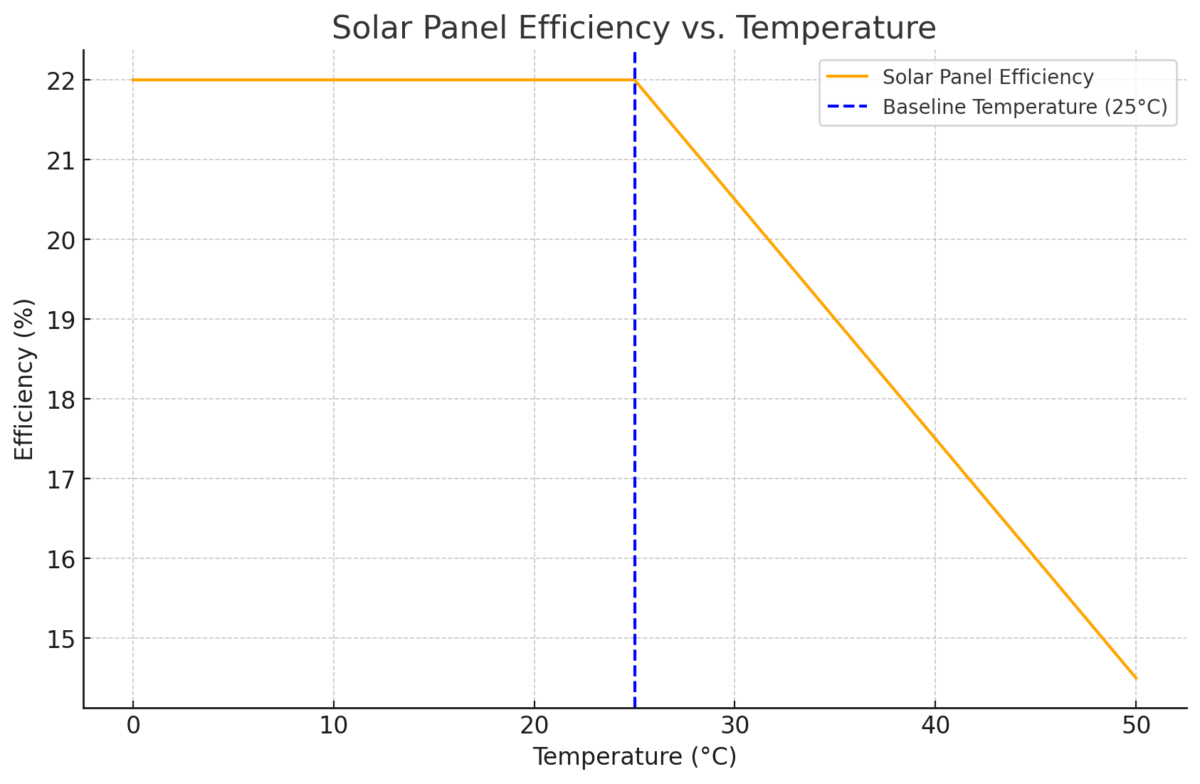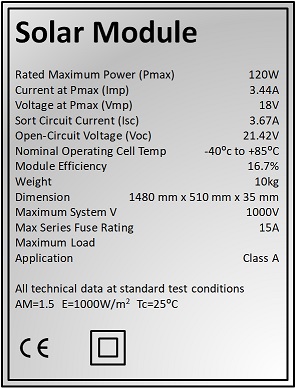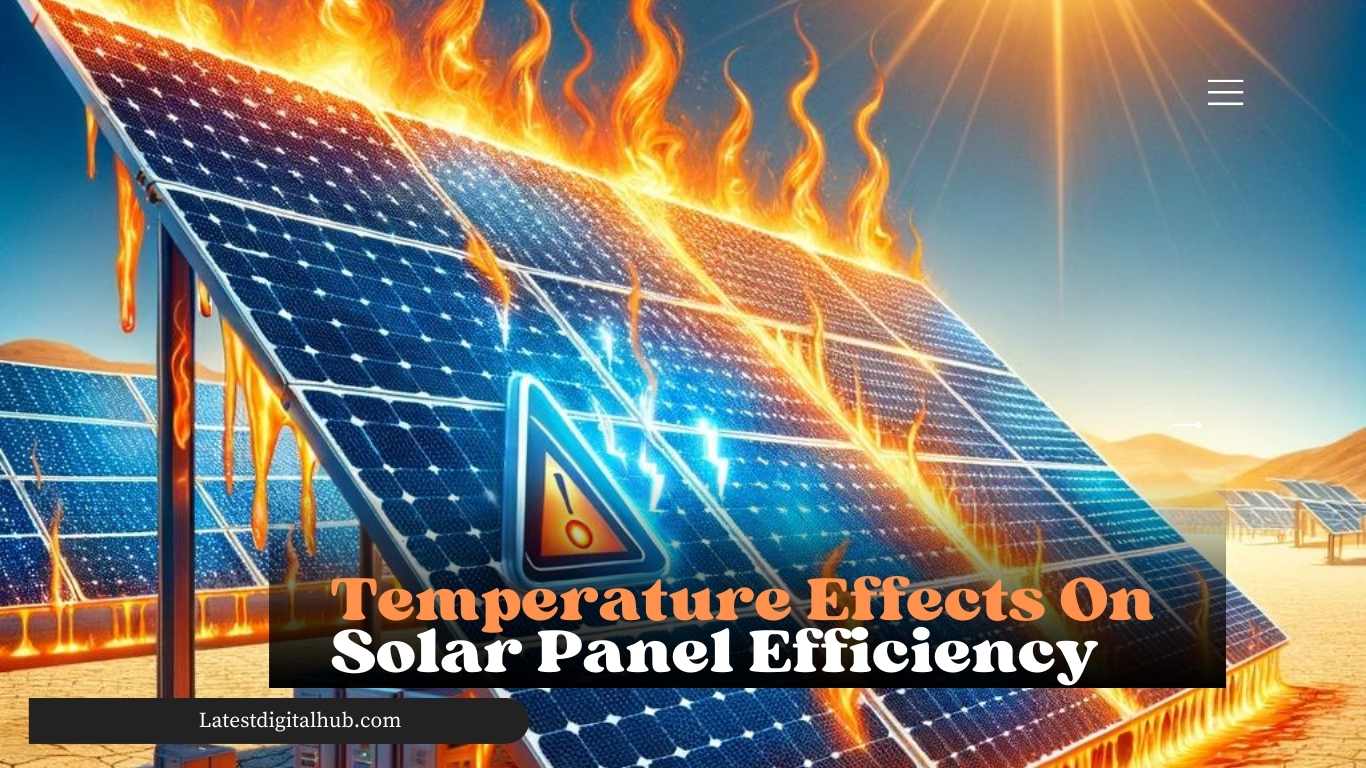Table of Contents
Is your solar panles getting to much hot and you need solution ? we will discuss Temperature Effects On Solar Panel Efficiency with causes solution and panel selection
Introduction to Solar Panel Efficiency and Temperature
The relationship between solar panel efficiency and temperature is a pivotal one and strongly influences the performance of a photovoltaic system. Solar panels are created to convert sunlight into electricity at the highest possible efficiency, with around a 15% to 22% efficiency rating for most panel types. However, the efficiency is notably affected by the temperature of the solar panel. With the increase in temperature, the efficiency of a solar panel tends to decrease.
The semiconductor materials used in the production of solar cells generate electricity. The higher the temperature, the higher the energy of the atoms in the semiconductor; hence, the number of electron-hole pairs that recombine without triggering electricity production is increased, consequently resulting in a lower panel efficiency

This graph clearly shows that by increasing the temperature the efficiemcy of the solar system will decrease An illustration of this thermodynamic principle is made available by most manufacturers is the temperature coefficient on Pmax, normally expressed as the percentage of decline per one-degree rise in temperature from the benchmark 25°C temperature
If the temperature coefficient of a solar panel is -0.3%/°C, the output power of the panel will reduce by 0.3% for each degree above 25°C. Such information is quite important in mounting panels, given that some areas have naturally high temperatures.
The Science Behind Solar Panels and Heat
The science behind solar panels and heat is rooted in the photovoltaic effect, where solar cells convert sunlight directly into electricity. Solar panels are made up of many individual solar cells, which are typically composed of silicon, a semiconductor. When sunlight hits a solar cell, it knocks electrons loose from their atoms, allowing them to flow through the material to produce electricity. This flow of electrons is harnessed to produce an electric current.
The Optimal Temperature Range for Maximum Solar Efficiency
The optimal temperature range for maximum solar panel efficiency is typically around 15°C to 35°C (59°F to 95°F). This range can slightly vary depending on the specific solar panel technology and the manufacturer’s design. Silicon solar cells, which are the most common type used in photovoltaic panels, have their peak efficiency at moderate temperatures and under full sunlight conditions
The decrease in efficiency with temperature rise is quantified by the temperature coefficient, typically expressed as a percentage decrease in output per degree Celsius increase in temperature. A standard temperature coefficient for power output (Pmax) is in the range of -0.3% to -0.5%/°C. This means that for every degree above 25°C, the maximum power output of the solar panel decreases by this percentage.
The Impact of High Temperatures on Solar Panels
High temperatures can significantly impact solar panels, primarily by reducing their efficiency and, over time, potentially affecting their operational lifespan as we can also see in the upper figure
The material expansion due to high temperatures can also affect solar panels by inducing mechanical stresses, which may lead to micro-cracks or physical degradation over time, further reducing efficiency and lifespan. Additionally, high temperatures can exacerbate the resistive losses within the solar panel’s wiring, connectors, and junction boxes, leading to further inefficiencies.
Solution for this is to use elevated mounting systems that enhance air circulation and cooling, as well as the use of heat-resistant materials. Advances in solar technology are continuously being made, including the development of solar cells with better high-temperature performance and the use of cooling systems to maintain optimal operating conditions, thereby improving efficiency and reliability in hotter climates.
How to increase Solar Performance in Hot Climates
Improving solar panel performance in hot climates can be approached by selecting materials and designs that are better suited to high temperatures. One key strategy is to choose solar panels with a low temperature coefficient for power output. This coefficient indicates the percentage decrease in output for each degree increase in temperature above 25°C.
Panels with a lower (less negative) coefficient are less affected by heat, thereby maintaining higher efficiency in hot conditions. Additionally, it is beneficial to use solar cells made from materials like monocrystalline silicon, which tend to have a better thermal performance than other types. Manufacturers are also developing panels with innovative materials such as amorphous silicon or organic photovoltaic cells that have better heat resistance.
Solar Panels for Hot Climates
Based on the latest information, here are some of the top solar panels that are well-suited for hot climates as detailed Below you can also check the latest solar panel with latest technology is Akcome solar Panels
| Brand | Model | Efficiency | Temperature Coefficient | Warranty |
|---|---|---|---|---|
| SunPower (Maxeon) | X-Series | 22.7% | -0.29%/°C | 25 years |
| Panasonic | Evervolt | 22.2% | -0.26%/°C | 25 years |
| REC Group | Alpha | 21.7% | -0.25%/°C | 25 years |
| Silfab Solar | Elite Series | 21.4% | -0.37%/°C | 30 years |
| Canadian Solar | Hiku 7 | 21.4% | -0.35%/°C | 25 years |
| Qcells (Hanwha) | Q.PEAK DUO-G5 | 21.4% | -0.35%/°C | 25 years |
| LG Solar | NeON R | 21.5% | -0.29%/°C | 25 years |
| Tesla | Solar Panels | ~22% | Low (exact value N/A) | N/A |
However, it should be noted that Monocrystalline panels are more often recommended, even in hot climates, due to their capacity. Nevertheless, the efficiency also depends on such aspects as the temperature coefficient of a particular model. In this case, SunPower, REC, and Panasonic’s models have been acknowledged to have increased efficiency and better temperature coefficients, rendering them the most suitable brands for hot areas
Practical Tips for Maintaining Solar Panels in Hot Weather
Properly maintaining solar panels in hot weather comprises various practical steps to ensure that they remain efficient. Solar panels require relatively low maintenance, and they must be checked regularly to notice any decrease in production. One of the factors to monitor is the energy production of the panels to notice a reduction, which can mean that the panels are getting dirty or there is an issue with the internal system.
Most of the solar systems have monitoring systems linked with an application that informs them in case of such an event. On the other hand, when it comes to cleaning, the angle of the panels may dictate the frequency. If the panels are at an angle, most of the dirt will be washed by the rain. However, in a relatively hot and dry environment that rains less, one should consider washing them two to four times a year.
It is advisable to clean the panels very early in the morning or very late in the evening to reduce smudges caused by quick drying. Use a soft brush or a clean cloth accompanied with deionized water since hard water causes mineral buildups. Abrasive materials and chemicals should be avoided as they may damage the panel surface. In case a repair is needed, it is advisable to contact a professional since a rooftop fault can cause more damage or personal injury and can void the warranty.
When one is in an area with extreme weather, they need to check the panels for damage after severe weather like storms or heavy snow as the snow on relatively dark panels melts faster and removes the dirt, which also cleans the panel. Finally, depending on the manufacturer, it is advisable to consult directly for maintenance
How To Check Best Solar Panels For Hot Climate Before Purchase
If you are going to purchase new solar panels for your home you must check the following guide for Hot area check the below image you can find this details which is written on the back side of the solar panel

Temperature Coefficient: The temperature coefficient is a measure of how the panel’s performance declines as the temperature rises. Choose a solar panel with a lower temperature coefficient of Pmax. A less negative temperature coefficient means the panel’s power output will not be as affected by high temperatures.
Nominal Operating Cell Temperature (NOCT): NOCT also gives an estimate of how the panel performs at common operating temperatures. Panels with a lower NOCT are preferred for better performance in hot conditions.
Material: Monocrystalline silicon, for example, performs better at high temperatures compared to polycrystalline siliconCooling & Ventilation Design:
Panels that are optimized to disperse heat or that allow for more airflow can operate better under high-temperature conditions.
Heat Resistant Solar Panel Technologies
Recent advancements in solar technology have led to improvements in heat resistance, such as Bifacial solar panels, which enhance efficiency by capturing sunlight on both sides. Their performance can be further improved when paired with solar tracking systems. Additionally, Concentration Photovoltaic Cell (CPV) systems employ optics to focus sunlight onto high-efficiency solar cells.
Although CPVs are less common in residential settings due to their complexity, they have demonstrated significant efficiency gains in laboratory environments. Another innovative development is multi-junction solar cells, which consist of multiple layers of photovoltaic materials, each designed to absorb different parts of the solar spectrum. This approach allows for more efficient conversion of sunlight into electricity by utilizing a broader range of the spectrum
FAQ
What is the optimal temperature range for solar panel efficiency?
Solar panels typically perform best in temperatures ranging from 15°C to 35°C (59°F to 95°F). Efficiency decreases as temperatures rise above this range due to the increased vibration of atoms in the solar cells, which negatively affects the electrical generation process.
Can solar panel efficiency improve in hot climates, and how?
Yes, using heat-resistant technologies such as monocrystalline panels with low temperature coefficients can help maintain efficiency in hot climates.
How should solar panels be maintained in hot weather?
Panels should be monitored regularly for any efficiency drops, cleaned two to four times a year, preferably in the morning or evening to prevent quick drying and smudging, and any repairs should be carried out by professionals to avoid voiding warranties

